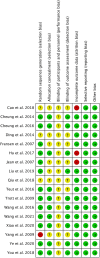Are Mind-Body Exercise Beneficial for Treating Pain, Function, and Quality of Life in Middle-Aged and Old People With Chronic Pain? A Systematic Review and Meta-Analysis
- PMID: 35800981
- PMCID: PMC9255956
- DOI: 10.3389/fnagi.2022.921069
Are Mind-Body Exercise Beneficial for Treating Pain, Function, and Quality of Life in Middle-Aged and Old People With Chronic Pain? A Systematic Review and Meta-Analysis
Abstract
Background: Aging is a significant risk factor in chronic pain development with extensive disability and greater health care costs. Mind-body exercise (MBE) has been scientifically proven to affect the pain intensity and physical health.
Objectives: To assess the effects of MBE modes (Tai Chi, yoga, and qigong) for treating chronic pain among middle-aged and old people, compared with nonactive and active treatment, as well as function, quality of life, and adverse events.
Methods: We searched PubMed, Embase, Web of Science, Cochrane Library, China National Knowledge Infrastructure (CNKI), Wanfang Database, and Chinese Scientific Journals Full-Text Database (VIP) till March 2022. No restrictions were chartered within the year and language of publication. We included randomized controlled trials of MBE treatment in middle-aged and elderly people with chronic pain. The overall certainty of evidence was evaluated by using the GRADE approach.
Results: A total of 17 studies (n = 1,332) were included in this review. There was low-certainty evidence indicating that MBE had a moderate effect on reducing pain compared with the nonactive and active control group (standard mean difference (SMD): -0.64, 95% confidence interval (CI): -0.86 to -0.42, P < 0.001). Very-low-certainty evidence showed that the pooled SMD for the functional improvement was -0.75 (95% CI: -1.13 to -0.37, P < 0.001). Low-certainty evidence presented that no influence was observed in physical component summary (SMD: 0.23, 95% CI: -0.16 to 0.62, P = 0.24) and mental component summary (SMD: -0.01, 95% CI -0.39 to 0.36, P = 0.95).
Conclusion: Our results indicated that MBE was an effective treatment for reducing symptoms of middle-aged and elderly people with chronic pain compared with nonactive and active control groups. TC and qigong had obvious benefits for knee osteoarthritis in self-reported function, but the efficacy of chronic low back pain was uncertain. No significant benefit of MBE on quality of life in older adults with chronic pain was found. More high-quality RCTs should be conducted to explore the efficacy and mechanism of MBE on chronic pain in middle-aged and elderly people from various dimensions, such as affective and cognitive dimensions.
Systematic review registration: https://www.crd.york.ac.uk/PROSPERO/display_record.php?RecordID=316591, identifier CRD42022316591.
Keywords: chronic pain; meta-analysis; mind-body exercises; old people; systematic review.
Copyright © 2022 Wen, Shi, Wang, Lin, Hu, Lin, Wang and Wang.
Conflict of interest statement
The authors declare that the research was conducted in the absence of any commercial or financial relationships that could be construed as a potential conflict of interest.
Figures








References
-
- Bellamy N., Buchanan W. W., Goldsmith C. H., Campbell J., Stitt L. W. (1988). Validation study of WOMAC: a health status instrument for measuring clinically important patient relevant outcomes to antirheumatic drug therapy in patients with osteoarthritis of the hip or knee. J. Rheumatol. 15, 1833–1840. - PubMed
Publication types
LinkOut - more resources
Full Text Sources

